Morocco is a land of vibrant colors, rich history, and stunning contrasts. From the bustling medinas of ancient cities to the serene stretches of desert and coastal beauty, this North African gem offers countless experiences to travelers. Here are the top 20 things to see and do in Morocco, showcasing its unique blend of Arab, Berber, and European influences.
1. Venture to the Heart of Marrakech
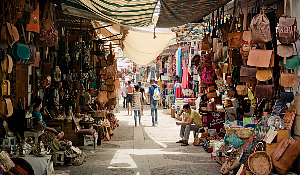 Discover the bustling medina, a maze of narrow streets filled with souks selling spices, textiles, and handcrafted goods. At its center lies Jemaa el-Fnaa, a lively square teeming with food stalls, snake charmers, henna artists, and storytellers. The medina offers a sensory overload, with the aroma of fresh mint tea and saffron filling the air. By day, it’s a hub for shopping and sightseeing, while at night, it transforms into an open-air theater of Moroccan culture. Don’t miss sampling traditional dishes like harira soup or tangy pastilla from the food stalls.
Discover the bustling medina, a maze of narrow streets filled with souks selling spices, textiles, and handcrafted goods. At its center lies Jemaa el-Fnaa, a lively square teeming with food stalls, snake charmers, henna artists, and storytellers. The medina offers a sensory overload, with the aroma of fresh mint tea and saffron filling the air. By day, it’s a hub for shopping and sightseeing, while at night, it transforms into an open-air theater of Moroccan culture. Don’t miss sampling traditional dishes like harira soup or tangy pastilla from the food stalls.
While in Marrakesh, visit the Majorelle Garden, an oasis in the city, designed by French artist Jacques Majorelle and later owned by Yves Saint Laurent. The striking cobalt-blue buildings, surrounded by exotic plants and fountains, make it a peaceful escape and a photographer’s paradise.
2. Wander the Blue Streets of Chefchaouen
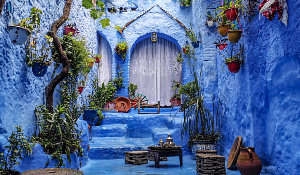 Known as the “Blue Pearl,” Chefchaouen is one of the most photogenic towns in Morocco. The blue-painted walls, believed to symbolize spirituality or repel insects, create a calming and magical atmosphere. Meander through its narrow streets, stopping by artisan shops selling handmade wool garments, pottery, and leather goods. Climb to the Spanish Mosque on the hilltop for panoramic views of the town and surrounding mountains. The peaceful vibe of Chefchaouen is perfect for unwinding and immersing yourself in Morocco’s slower pace of life.
Known as the “Blue Pearl,” Chefchaouen is one of the most photogenic towns in Morocco. The blue-painted walls, believed to symbolize spirituality or repel insects, create a calming and magical atmosphere. Meander through its narrow streets, stopping by artisan shops selling handmade wool garments, pottery, and leather goods. Climb to the Spanish Mosque on the hilltop for panoramic views of the town and surrounding mountains. The peaceful vibe of Chefchaouen is perfect for unwinding and immersing yourself in Morocco’s slower pace of life.
3. See the Sahara
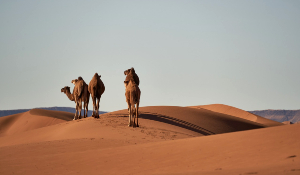 The golden dunes of the Sahara Desert are one of Morocco’s most iconic landscapes. Embark on a camel trek across the sand, where the rhythmic sway of the ride and the vast emptiness around you create a serene experience. Spend a night at a traditional Berber camp, enjoying a hearty meal under a canopy of stars while listening to local music. For thrill-seekers, sandboarding or a 4×4 desert excursion adds a dose of adventure. Witnessing both the sunrise and sunset over the dunes is an unforgettable highlight.
The golden dunes of the Sahara Desert are one of Morocco’s most iconic landscapes. Embark on a camel trek across the sand, where the rhythmic sway of the ride and the vast emptiness around you create a serene experience. Spend a night at a traditional Berber camp, enjoying a hearty meal under a canopy of stars while listening to local music. For thrill-seekers, sandboarding or a 4×4 desert excursion adds a dose of adventure. Witnessing both the sunrise and sunset over the dunes is an unforgettable highlight.
4. Tour Hassan II Mosque in Casablanca
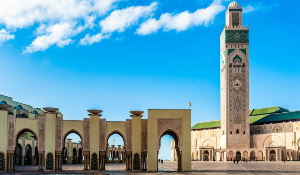 Overlooking the Atlantic Ocean, the Hassan II Mosque is a stunning example of modern Islamic architecture. Its 210-meter minaret is the tallest in the world, and the mosque’s interior features exquisite mosaics, woodwork, and chandeliers. Guided tours provide fascinating insights into its construction and symbolism. The location, with waves crashing against the shore, adds to the mosque’s dramatic presence.
Overlooking the Atlantic Ocean, the Hassan II Mosque is a stunning example of modern Islamic architecture. Its 210-meter minaret is the tallest in the world, and the mosque’s interior features exquisite mosaics, woodwork, and chandeliers. Guided tours provide fascinating insights into its construction and symbolism. The location, with waves crashing against the shore, adds to the mosque’s dramatic presence.
5. Admire the Bahia Palace
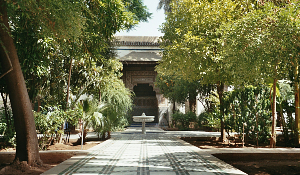 Located in Marrakech, this palace is a masterpiece of Moroccan architecture and design. Bahia Palace was built in the late 19th century for a grand vizier of the sultan. Its name, “Bahia,” meaning “brilliance,” reflects the palace’s intended purpose as a dazzling residence. The complex spans over 150 rooms, including private quarters, courtyards, and lush gardens filled with orange trees and fountains. Intricate tilework, carved cedar wood ceilings, and stucco details showcase the craftsmanship of the era. Visitors can wander through the labyrinthine halls and courtyards, while envisioning royal life in the 19th century. The large marble courtyard is particularly striking, bathed in light and surrounded by colorful mosaics and columns.
Located in Marrakech, this palace is a masterpiece of Moroccan architecture and design. Bahia Palace was built in the late 19th century for a grand vizier of the sultan. Its name, “Bahia,” meaning “brilliance,” reflects the palace’s intended purpose as a dazzling residence. The complex spans over 150 rooms, including private quarters, courtyards, and lush gardens filled with orange trees and fountains. Intricate tilework, carved cedar wood ceilings, and stucco details showcase the craftsmanship of the era. Visitors can wander through the labyrinthine halls and courtyards, while envisioning royal life in the 19th century. The large marble courtyard is particularly striking, bathed in light and surrounded by colorful mosaics and columns.
6. Explore Rabat’s Kasbah
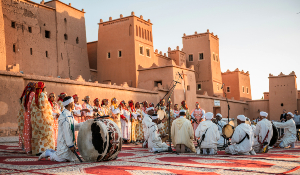 Morocco’s capital city combines history with a cosmopolitan feel. The Kasbah of the Udayas, a historic fortress overlooking the Atlantic, features narrow streets lined with blue-and-white buildings reminiscent of Chefchaouen. Its Andalusian gardens and tranquil atmosphere make it a peaceful spot for a stroll. The views from the kasbah walls are spectacular, especially during sunset.
Morocco’s capital city combines history with a cosmopolitan feel. The Kasbah of the Udayas, a historic fortress overlooking the Atlantic, features narrow streets lined with blue-and-white buildings reminiscent of Chefchaouen. Its Andalusian gardens and tranquil atmosphere make it a peaceful spot for a stroll. The views from the kasbah walls are spectacular, especially during sunset.
7. Visit Volubilis
 This ancient Roman city, near Meknes, is a testament to Morocco’s rich history as a crossroads of civilizations. The site features well-preserved ruins, including basilicas, baths, and triumphal arches, along with intricate mosaics depicting Roman mythology.
This ancient Roman city, near Meknes, is a testament to Morocco’s rich history as a crossroads of civilizations. The site features well-preserved ruins, including basilicas, baths, and triumphal arches, along with intricate mosaics depicting Roman mythology.
A visit to Volubilis offers a fascinating glimpse into the region’s past and stunning views of the surrounding countryside.
8. Discover Ait Benhaddou
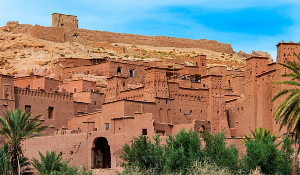 This ancient ksar, or fortified village, is one of Morocco’s most iconic sites. Its earthen clay architecture has been preserved for centuries and has featured in films like Gladiator and Game of Thrones. Explore the winding pathways and climb to the top for panoramic views of the surrounding landscape. The site is particularly magical at sunset when the golden light highlights its earthy tones.
This ancient ksar, or fortified village, is one of Morocco’s most iconic sites. Its earthen clay architecture has been preserved for centuries and has featured in films like Gladiator and Game of Thrones. Explore the winding pathways and climb to the top for panoramic views of the surrounding landscape. The site is particularly magical at sunset when the golden light highlights its earthy tones.
9. Relax in Essaouira
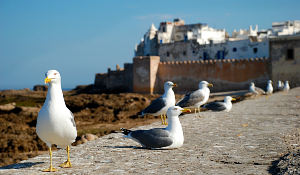 This is a charming coastal town on Morocco’s Atlantic shore and offers a perfect blend of history and culture. Essaouira’s laid-back vibe is a stark contrast to the energy of larger cities, making it an ideal spot to unwind. Visitors can stroll along the sandy beach, a popular spot for windsurfing and kitesurfing due to the constant Atlantic breeze. Fresh seafood is a highlight here—don’t miss the grilled fish stalls near the port for an authentic dining experience. With its bohemian atmosphere and artistic charm, Essaouira has long been a haven for creatives and travelers seeking a serene escape.
This is a charming coastal town on Morocco’s Atlantic shore and offers a perfect blend of history and culture. Essaouira’s laid-back vibe is a stark contrast to the energy of larger cities, making it an ideal spot to unwind. Visitors can stroll along the sandy beach, a popular spot for windsurfing and kitesurfing due to the constant Atlantic breeze. Fresh seafood is a highlight here—don’t miss the grilled fish stalls near the port for an authentic dining experience. With its bohemian atmosphere and artistic charm, Essaouira has long been a haven for creatives and travelers seeking a serene escape.
10. Feast on Moroccan Cuisine
 Moroccan food is a vibrant blend of Berber, Arab, and Mediterranean influences, with spices at its heart. Markets overflow with colorful heaps of saffron, cumin, cinnamon, and ras el hanout, a fragrant spice blend unique to each vendor. Tagines, slow-cooked stews of meat and vegetables, are the country’s signature dish, often flavored with preserved lemons and olives. Couscous, served with rich broths, is another staple found at family tables and celebrations alike. Sweet treats like almond-filled pastilla and honey-drenched chebakia balance the bold savory dishes. Meals are accompanied by the ritual of mint tea, a symbol of hospitality and friendship. Moroccan food is as much about the experience as the taste, with its warm, communal atmosphere and rich, aromatic flavors.
Moroccan food is a vibrant blend of Berber, Arab, and Mediterranean influences, with spices at its heart. Markets overflow with colorful heaps of saffron, cumin, cinnamon, and ras el hanout, a fragrant spice blend unique to each vendor. Tagines, slow-cooked stews of meat and vegetables, are the country’s signature dish, often flavored with preserved lemons and olives. Couscous, served with rich broths, is another staple found at family tables and celebrations alike. Sweet treats like almond-filled pastilla and honey-drenched chebakia balance the bold savory dishes. Meals are accompanied by the ritual of mint tea, a symbol of hospitality and friendship. Moroccan food is as much about the experience as the taste, with its warm, communal atmosphere and rich, aromatic flavors.
Photo Credits:
Lead – Image by Louis Hansel on Unsplash
Marrakech – Image by TheUjulala from Pixabay
Chefchaouen – Photo by Kyriacos Georgiou on Unsplash
Sahara Desert – Image by Wolfgang_Hasselmann from Pixabay
Bahia Palace – Photo by Niel Taelman on Unsplash
Rabat’s Kasbah – Photo by Abdou Faiz on Unsplash
Ait Benhaddou – Image by sosinda from Pixabay
Hassan ll Mosque – Image by Hans-Juergen Weinhardt from Pixabay
Volubilis – Image by Yolanda Coervers from Pixabay
Essaouira – Image by Zigor Agirrezabala Vitoria from Pixabay
Spices/Cuisine – Image by Rudy and Peter Skitterians from Pixabay


